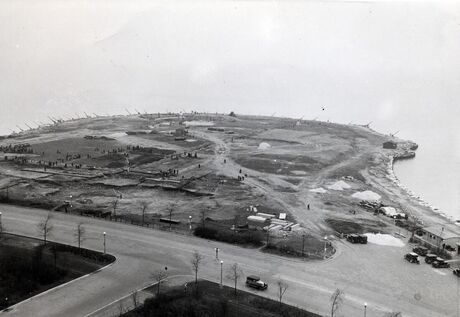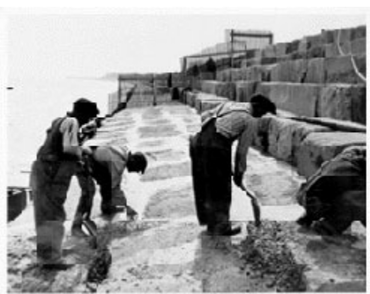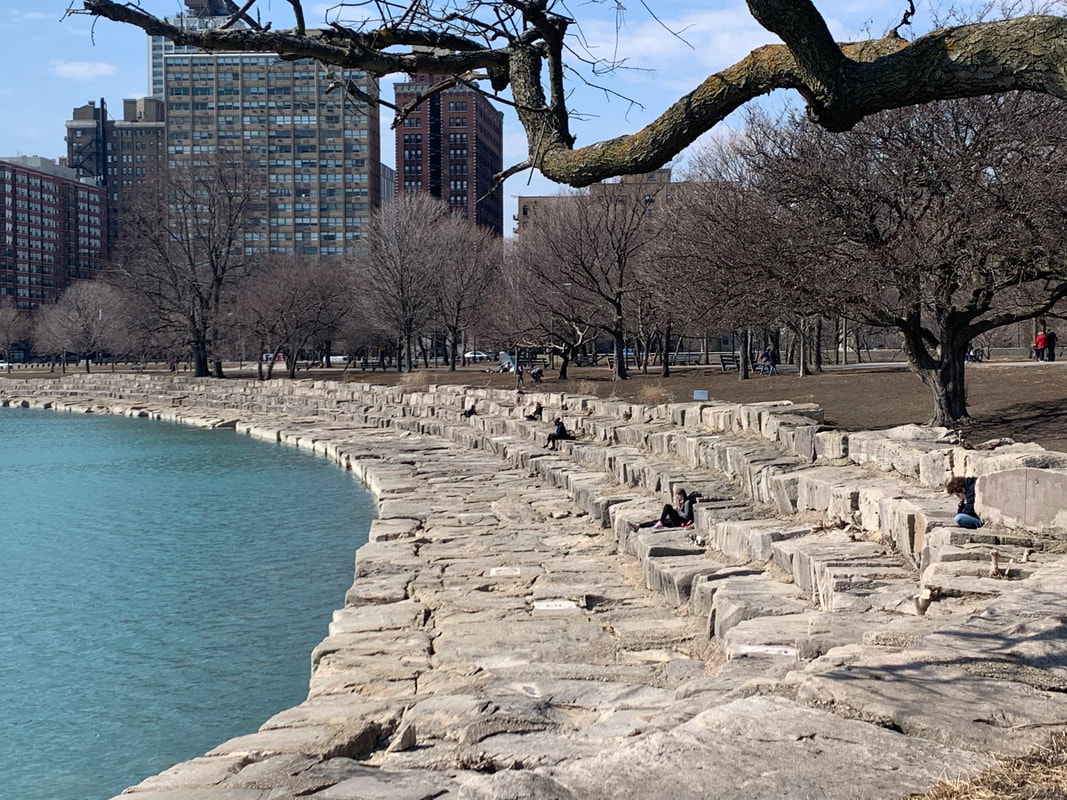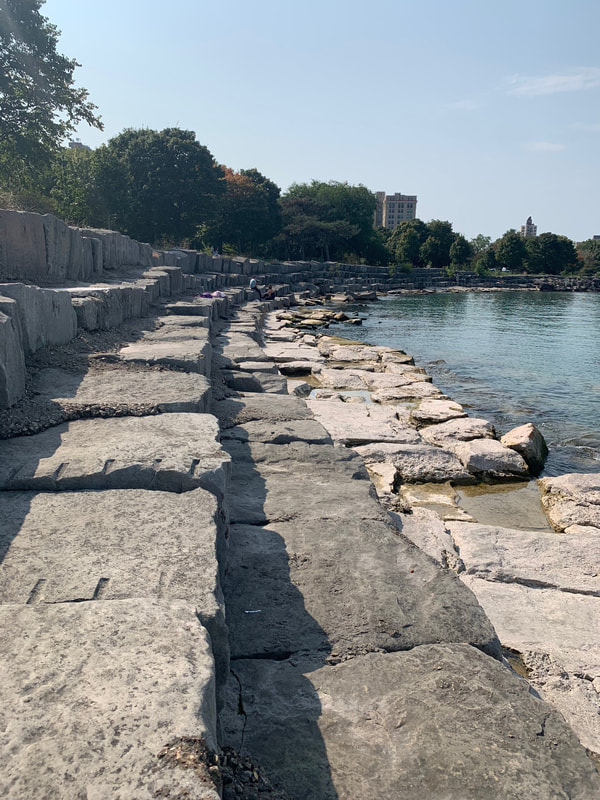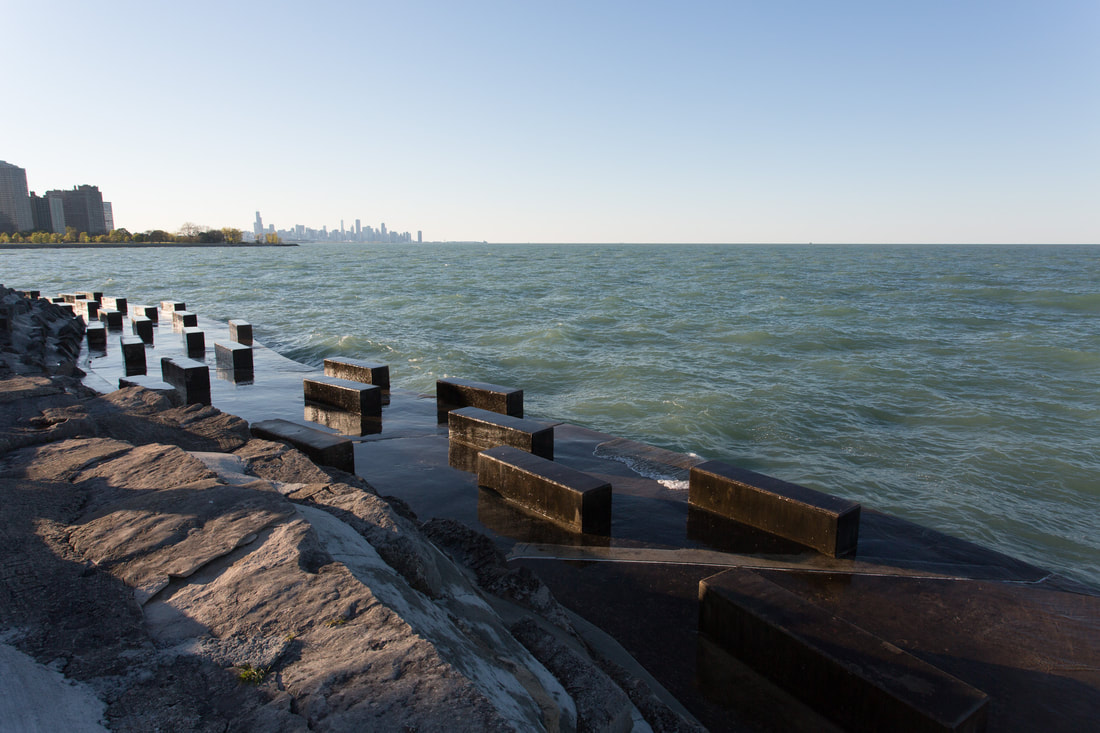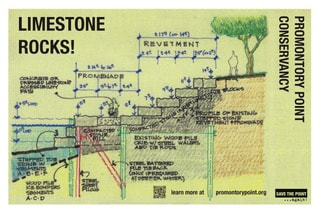|
As a three-sided peninsula, the Point calls for three different types of preservation on its south, north and east sides. The Secretary of the Interior (SOI) Standards for Historic Preservation classify repair, restoration and rehabilitation as legitimate methods of preservation construction. It is important to know that the limestone, step-stone revetment still functions after 85 years and little maintenace. This tells us that the original design of the Point's revetment can remain the design for fixing and maintaining it and this design makes genuine preservation completely feasible. Repair-in-place For example, the south side of the Point where the revetment is spared the hard pounding northeast wave action can be repaired-in-place. Without dismantling the revetment, new steel pilings can be added to reinforce the decaying wooden ones and the limestone blocks can be repositioned and regrouted in place without dismantling the revetment. Early photographs of the construction of the Point show how this repair-in-place can happen. In the left photo, a series of small cranes on the parkland -- or on barges in the water, move the limestone blocks into position. On the right, once in place, the blocks were grouted with concrete. The south side revetment can be repaired-in-place. Restoration On the north side of the Point, the limestone and the cove see a lot more winter wave action causing more erosion and shifting of the rocks. Here many of the stone blocks will need to be repaired and repositioned, again using small cranes on the parkland or on barges, and some will need to be restored and replaced with new blocks of the same material. Again the wooden crib can be reinforced with new steel pilings. Replacement blocks are available in Bedford County, Indiana, where all the limestone at the Point originally came from. Using these limestone blocks for a revetment/sea wall was a repurposing project in 1936-37. These blocks were cut from Indiana quarries but because of blemishes or fissures they could not be used for the exterior stone of many of the older buildings in downtown Chicago, on the University of Chicago campus and at the Pentagon. Mountains of these rejected stone blocks line the roadways in Bedford County near the quarries. They are available by the hundreds for replacement blocks at the Point. The north stretch of the Point can be repaired-in-place or can be fixed with restoration methods replacing damaged limestone blocks with identical existing materials . Rehabilitation: a more expensive option than repair The SOI Standards allow for changes that are in the spirit of the original design but are required for modern use. For example, the Lincoln boyhood home is preserved but with electrical lights so guests may see their way around the building safely. At the east end of the Point, the historic limestone revetment is already compromised by the 1964 concrete promonade and coffins put in by the Chicago Park District because of erosion damage. (The stones from the original promonade may be seen in the water immediately off the coffins platform.) At the eastern-northeastern revetment, wave action has eroded the fill beneath the concrete-coffin promonade, in a few places all the way into the parkland. Over its 85 year history, the erosion of the fill has caused the limestone step-stones at the north east section to tip back into the parkland because of their weight. The cheapest alternative would be to repair-in-place this section most damaged by wave action. Foam concrete can be pumped in under the coffins-platform to replace the fill eroded by storm waves. The step-stone blocks, which right now are tipped back into the parkland, could be left as is without harm or could be repaired-in-place. Another row of limestone blocks at the parkland level and some protective fabrics would secure the adjoining parkland at minimal cost and provide improved storm protection. Since this section is already historically compromised by the 1964 coffins and has the most erosion damage, it allows for all sorts of creative rehabilitation (per SOI Standards) possibilities that maximize the limestone while incorporating concrete for pathways down to the promenade and the water. This might be the best location for innovative ADA compliance with ramps and ropes, and toe stones that permit wheel-chair bound swimmers access into the water. It also gives them proximity from the promonade to the nearby restrooms in the field house. Since the Chicago Park District, the City and the Chicago US Army Corps want a "world-class solution" appropriate a world-class city, SOI rehabilitation and its additional expense might be justified and open up innovative and creative ways to maximize the historic limestone, minimize concrete using sustainable methods, and enhance access to the water for all. Here you can see the 1964 concrete promendade with the coffins and the step-stone revetment tipped back into the parkland. The east end of the Point suffers the brunt of severe storms and can be repaired-in-place. Or it might be rehabilitated to maximize the historic limestone and minimize the concrete per Secretary of the Interior Standards at additonal expense. 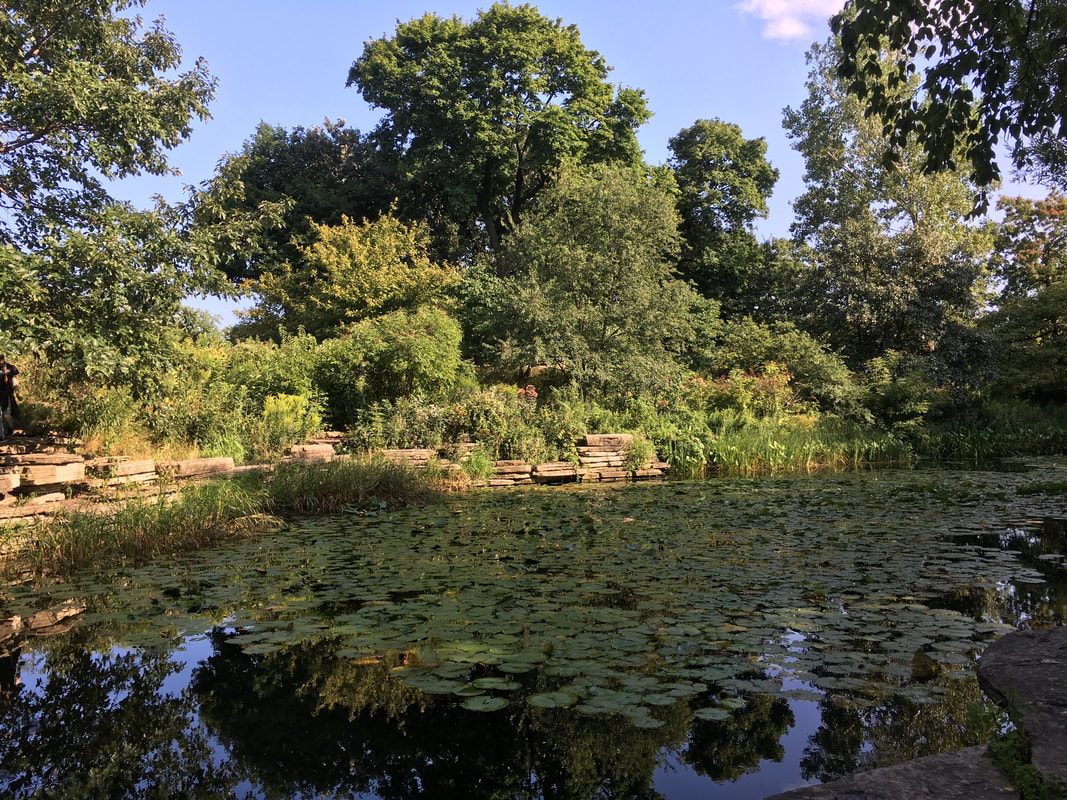 A wonderful example of rehabilitation is Lincoln Park's Alfred Caldwell Lily Pool which was repaired, restored and rehabilitated per SOI Standards to accomodate visitors in wheelchairs. The Lily Pool, another Caldwell design, is a National Historic Landmark and a Chicago landmark and, like the Point, draws visitors from across the City and the world.
12 Comments
Cost Points: cost comparisons of the "locally preferred plan" and preservation construction11/1/2022  We recently discovered -- again -- that repair, restoration and rehabilitation of Promontory Point continues to be cost-effective and cheaper than the City's "locally preferred plan". As you may recall, the City's "locally preferred plan" entails demolition of the historic limestone revetment and new construction of concrete and steel. In 2013, the U.S. Army Corps of Engineers' cost estimate for the "locally preferred plan" was $57m. Adjusted for inflation, the cost of the "locally preferred plan" today is: $75m In sharp contrast, preservation of the Point -- repair, restoration and rehabilitation per the Secretary of the Interior Standards for Historic Preservation -- continues to be cheaper than demolition and new construction. The 2002 Cyril Galvin preservation marine engineering report estimated the cost of repair, restoration and rehabilitation at $4.5m. Adjusted for inflation, that's currently $7.53m, 1/10th the cost of the "locally preferred plan". Given the storm damage erosion at the Point since 2002 and after conversation with four marine engineering firms with preservation experience, we estimate the cost of preservation construction and maintenance at 1/5 - 1/2 the cost of the "locally preferred plan" at: $17-29m Right now, the City is pushing a deception Point: demolition of the limestone revetment, new construction of a concrete revetment with limestone blocks on top as decorative and ornamental. Astronomical to build and to maintain, it is an over-engineered solution for $100m when repair, restoration and rehabilitation of the existing limestone revetment is feasible and multiple times cheaper. This is not a preservation-based approach and violates the Secretary of the Interior Standards for Historic Preservation. We don't need a new concrete revetment. We need the existing limestone revetment -- which still functions at 85 years -- fixed. But even if preservation costs as much as the "locally preferred plan" which it doesn't, Promontory Point would be worth it and park equity on the South Side would be served. |
Categories
All
Archives
July 2024
AuthorDebra Hammond is currently an officer of Promontory Point Conservancy. She has always been tall for her age |
